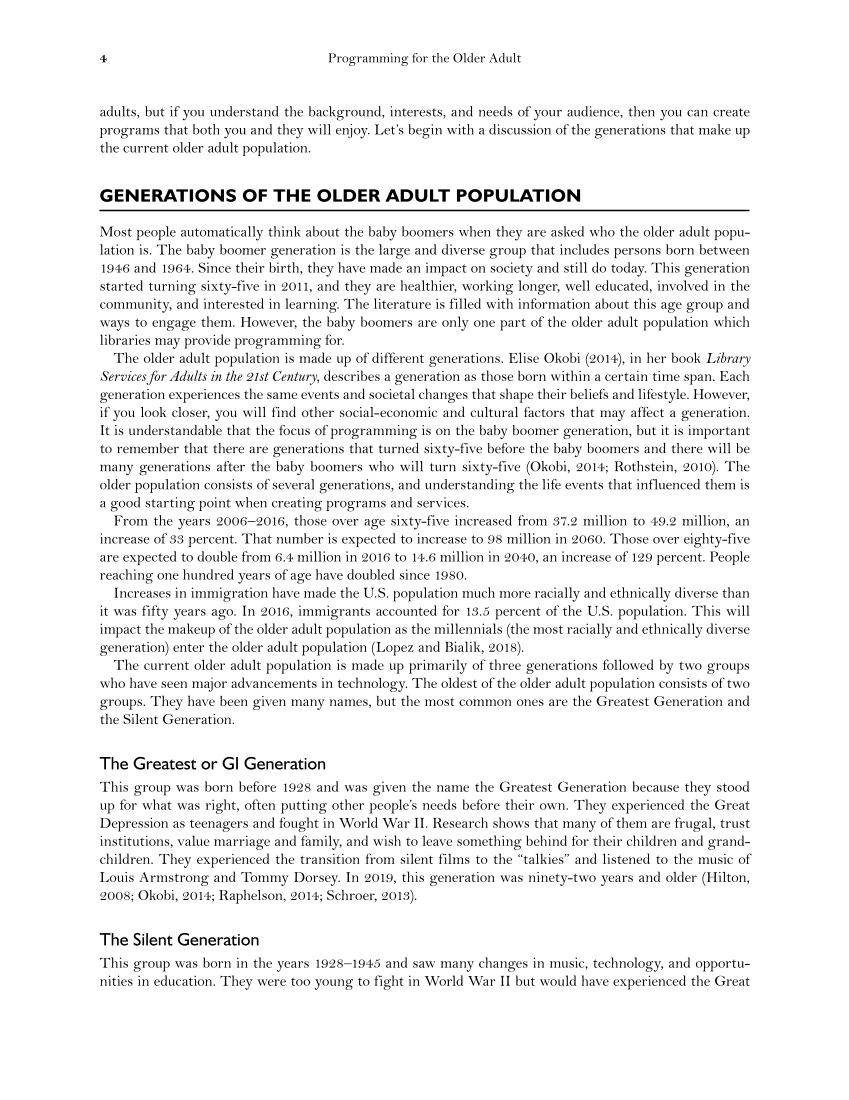4 Programming for the Older Adult adults, but if you understand the background, interests, and needs of your audience, then you can create programs that both you and they will enjoy. Let’s begin with a discussion of the generations that make up the current older adult population. GENERATIONS OF THE OLDER ADULT POPULATION Most people automatically think about the baby boomers when they are asked who the older adult popu- lation is. The baby boomer generation is the large and diverse group that includes persons born between 1946 and 1964. Since their birth, they have made an impact on society and still do today. This generation started turning sixty-five in 2011, and they are healthier, working longer, well educated, involved in the community, and interested in learning. The literature is filled with information about this age group and ways to engage them. However, the baby boomers are only one part of the older adult population which libraries may provide programming for. The older adult population is made up of different generations. Elise Okobi (2014), in her book Library Services for Adults in the 21st Century , describes a generation as those born within a certain time span. Each generation experiences the same events and societal changes that shape their beliefs and lifestyle. However, if you look closer, you will find other social-economic and cultural factors that may affect a generation. It is understandable that the focus of programming is on the baby boomer generation, but it is important to remember that there are generations that turned sixty-five before the baby boomers and there will be many generations after the baby boomers who will turn sixty-five (Okobi, 2014 Rothstein, 2010). The older population consists of several generations, and understanding the life events that influenced them is a good starting point when creating programs and services. From the years 2006–2016, those over age sixty-five increased from 37.2 million to 49.2 million, an increase of 33 percent. That number is expected to increase to 98 million in 2060. Those over eighty-five are expected to double from 6.4 million in 2016 to 14.6 million in 2040, an increase of 129 percent. People reaching one hundred years of age have doubled since 1980. Increases in immigration have made the U.S. population much more racially and ethnically diverse than it was fifty years ago. In 2016, immigrants accounted for 13.5 percent of the U.S. population. This will impact the makeup of the older adult population as the millennials (the most racially and ethnically diverse generation) enter the older adult population (Lopez and Bialik, 2018). The current older adult population is made up primarily of three generations followed by two groups who have seen major advancements in technology. The oldest of the older adult population consists of two groups. They have been given many names, but the most common ones are the Greatest Generation and the Silent Generation. The Greatest or GI Generation This group was born before 1928 and was given the name the Greatest Generation because they stood up for what was right, often putting other people’s needs before their own. They experienced the Great Depression as teenagers and fought in World War II. Research shows that many of them are frugal, trust institutions, value marriage and family, and wish to leave something behind for their children and grand- children. They experienced the transition from silent films to the “talkies” and listened to the music of Louis Armstrong and Tommy Dorsey. In 2019, this generation was ninety-two years and older (Hilton, 2008 Okobi, 2014 Raphelson, 2014 Schroer, 2013). The Silent Generation This group was born in the years 1928–1945 and saw many changes in music, technology, and opportu- nities in education. They were too young to fight in World War II but would have experienced the Great
Document Details My Account Print multiple pages
Print
You have printed 0 times in the last 24 hours.
Your print count will reset on at .
You may print 0 more time(s) before then.
You may print a maximum of 0 pages at a time.








































































































































































